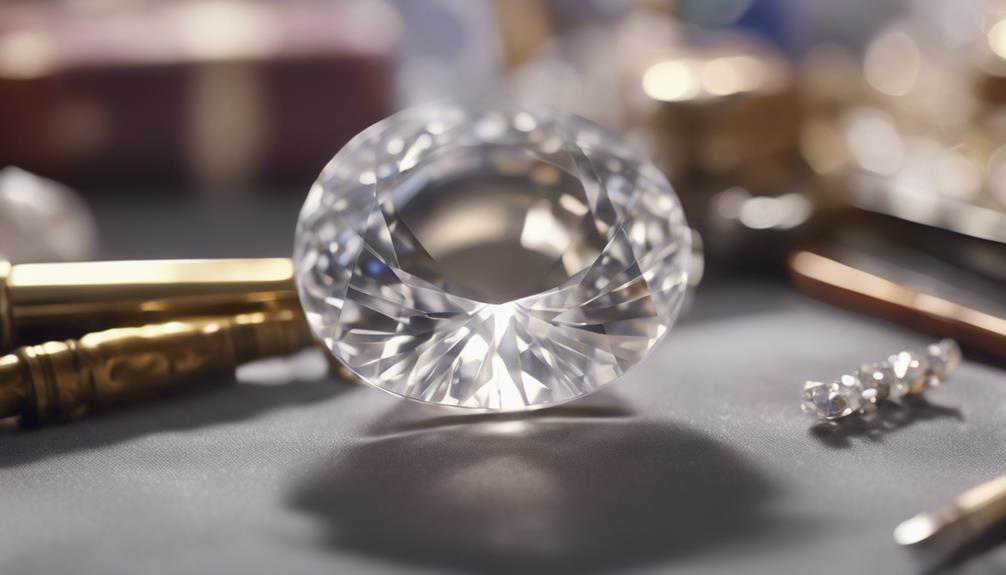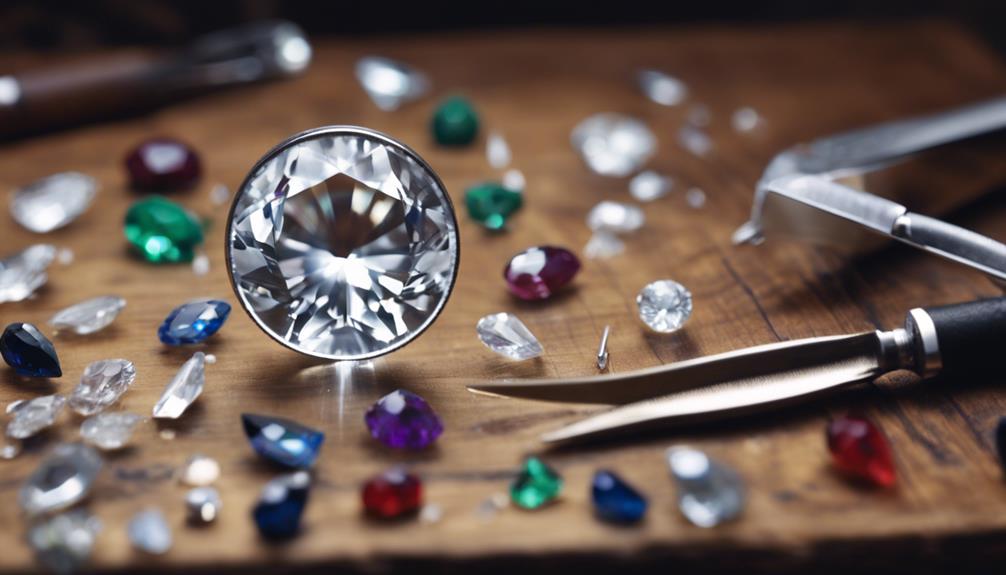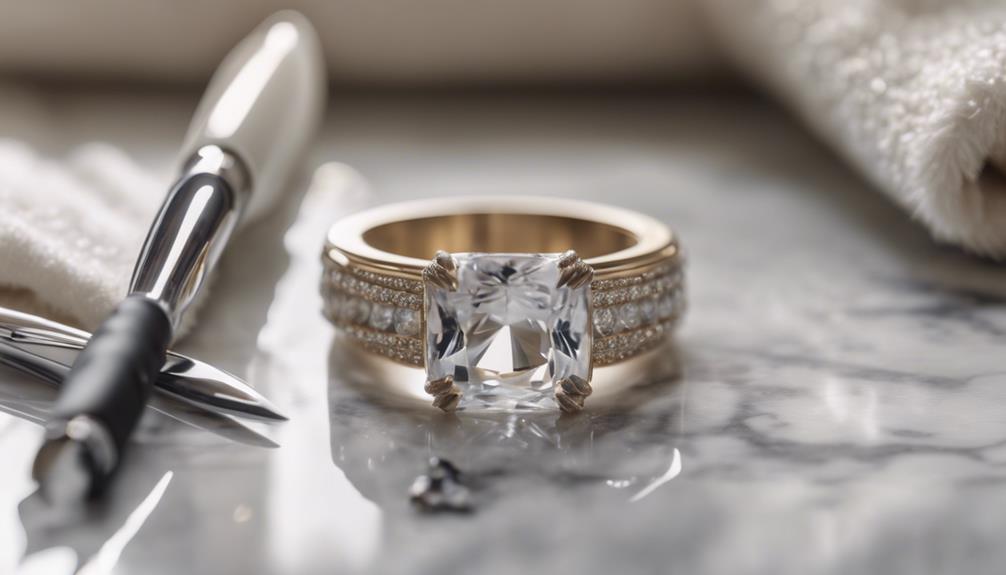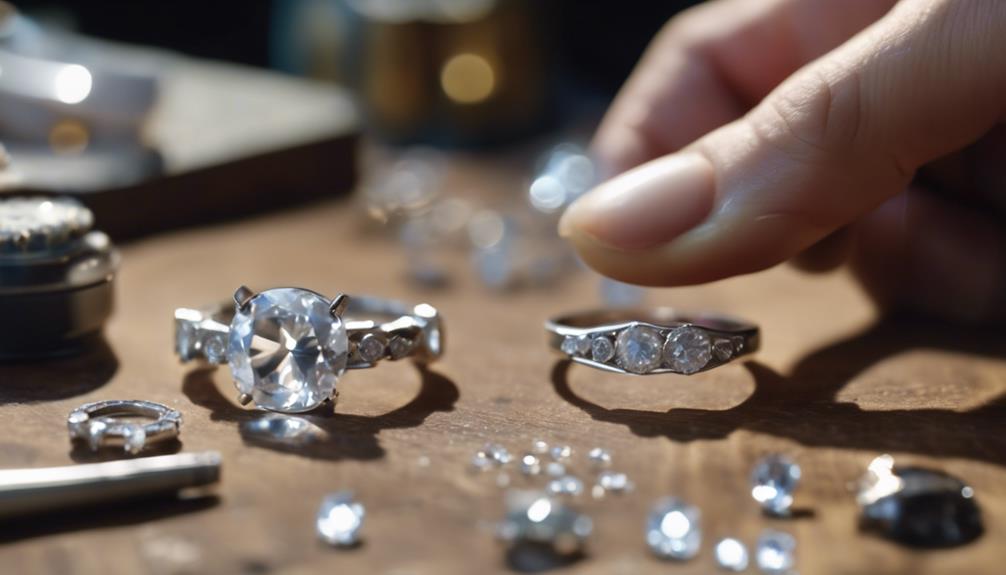When you’re buying a white sapphire, start by understanding that it’s a durable, cost-effective alternative to diamonds, though slightly softer. Look for a clear, colorless stone with minimal inclusions and a lively saturation, avoiding any yellow or gray hues. Verify authenticity with a gemological certificate and consider classic cuts like round or princess for brilliance. Reputable vendors like James Allen or Blue Nile are great options, and lab-created sapphires can offer ethical and budget-friendly choices. Keep evaluating the 4 Cs—color, cut, clarity, and carat weight—to guarantee quality and value. There’s much more to discover about these stunning gems.
Understanding White Sapphires

White sapphires, a colorless variant of the corundum family, offer a cost-effective alternative to diamonds while maintaining a striking visual appeal. They rank 9 on the Mohs scale, making them slightly softer than diamonds but still highly durable. You’ll find that they’re composed mainly of aluminum oxide with trace elements, which gives them their clear, transparent look.
White sapphires are often treated to enhance clarity since naturally occurring flawless specimens are rare. Commonly sourced from Southeast Asia, Africa, and the U.S., these gems can sometimes have a cloudy hue, setting them apart from other stones. To guarantee you’re getting an authentic white sapphire, always request a gemological certificate.
When evaluating white sapphires, keep in mind that inclusions are more common than in diamonds. While they may not have the same brilliance, their beauty is undeniable. Look for stones that exhibit good color tone, purity, and saturation. Initial assessments can be made with the naked eye, but professional evaluation is essential for accuracy.
Comparing White Sapphires and Diamonds
How do white sapphires stack up against diamonds regarding brilliance and durability?
When it comes to brilliance, diamonds take the lead. With a refractive index of 2.42, diamonds have superior sparkle and fire compared to white sapphires, which have a refractive index of 1.77. Under bright light, this difference is unmistakable, as diamonds consistently outshine white sapphires with respect to sparkle.
Durability is another key area where diamonds excel. Diamonds rank 10 on the Mohs scale, making them the hardest natural material and highly resistant to scratches. White sapphires, while still durable at a 9 on the Mohs scale, are slightly softer and more prone to accumulating scratches and dirt over time. This can result in a milky appearance that diminishes their brilliance.
However, white sapphires offer a more affordable alternative to diamonds without compromising too much on durability and visual appeal. They maintain their clarity better than cubic zirconia and are natural stones, unlike the synthetic cubic zirconia.
When considering larger stones, white sapphires become easier to distinguish from diamonds, especially given their rarity and price. Overall, while diamonds outperform in brilliance and durability, white sapphires provide a cost-effective and attractive option.
Evaluating White Sapphires

When evaluating white sapphires, focus on the key aspects like color tone, purity, saturation, and clarity.
You’ll want to look for a stone that has a clear, colorless appearance; any hint of yellow or gray can affect its beauty and value. Purity is essential—check for inclusions or blemishes that might be visible to the naked eye. While inclusions are more common in sapphires than in diamonds, a high-quality white sapphire will have minimal imperfections.
Saturation refers to the intensity of the stone’s color. For white sapphires, you’re aiming for a bright, lively appearance, not a dull or milky one. Clarity is also a significant factor; a clear stone allows light to pass through and enhances the gem’s overall sparkle.
When evaluating cut, confirm the sapphire has good symmetry and balance. Avoid stones with ‘windows’—areas where light passes straight through without reflecting back, diminishing the gem’s brilliance.
Initial evaluations can be done with the naked eye, but for a more thorough analysis, consider a gemological certificate. This document confirms the stone’s identity and any treatments it might’ve undergone, giving you confidence in your purchase.
Engagement Ring Options
Are you contemplating a white sapphire for your engagement ring and wondering which shape and setting will best showcase its beauty? You’re in for a treat because white sapphires offer stunning versatility.
Classic shapes like round and princess cuts are timeless and enhance the stone’s brilliance. If you prefer something unique, think about pear or cushion cuts, which add a personalized touch to your ring.
When it comes to settings, think about how you want to highlight the sapphire. A solitaire setting focuses all attention on the stone, allowing its natural beauty to shine. For extra sparkle, a halo setting surrounds the white sapphire with smaller diamonds or gems, amplifying its brilliance. If you like vintage charm, opt for a bezel setting, which securely encases the stone while providing an elegant, antique look.
Don’t forget to reflect on the metal for the band. White gold and platinum pair wonderfully with white sapphires, enhancing their icy allure. Rose gold offers a romantic, warm contrast.
Ultimately, the best choice aligns with your personal style and how you envision your dream ring. Choose wisely, and your white sapphire engagement ring will be a cherished symbol of your love.
Buying and Maintaining

After selecting the perfect shape and setting for your white sapphire engagement ring, it’s important to focus on the buying process and how to maintain your gemstone’s brilliance.
Begin by choosing reputable vendors like James Allen or Blue Nile, ensuring they provide gemological certificates for authenticity. Lab-created white sapphires can be a cost-effective and ethical alternative, identical in composition to natural ones.
When purchasing, pay attention to the 4 Cs—color, cut, clarity, and carat weight. While white sapphires aren’t graded like diamonds, these factors still influence the stone’s appearance and value. Look for clarity and minimal inclusions, as these impact the gem’s sparkle.
Maintaining your white sapphire involves regular cleaning to remove dirt and oils that can dull its shine. Use lukewarm water, mild soap, and a soft brush for gentle cleaning. Avoid harsh chemicals and ultrasonic cleaners, which can damage the stone.
Store your ring separately from other jewelry to prevent scratching.
Conclusion
Now that you’re equipped with essential knowledge about white sapphires, you can confidently explore this stunning and affordable alternative to diamonds.
Remember to take into account the 4 Cs, check for gemological certificates, and choose a shape that complements your style.
White sapphires offer unique charm and durability, making them a fantastic choice for engagement rings or everyday wear.
With this guide, you’ll find the perfect gemstone to fit your budget and personal taste.
Happy shopping!



